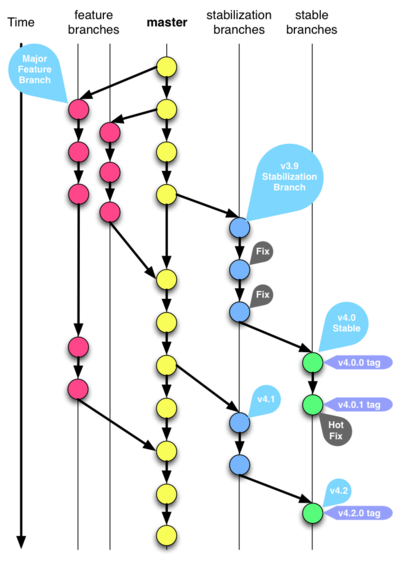Difference between revisions of "RepositoryStructure"
| (10 intermediate revisions by 3 users not shown) | |||
| Line 1: | Line 1: | ||
'''Repository Structure''' Refers to the way Paparazzi is naming the branches and which one is the right one for you. | '''Repository Structure''' Refers to the way Paparazzi is naming the [[Git]] branches and which one is the right one for you. | ||
[[Image:RepositoryBranching.png|400px|thumb|Branching Model Diagram]] | |||
== Development branch (master) == | |||
<span class="plainlinks">[https://travis-ci.org/paparazzi/paparazzi https://travis-ci.org/paparazzi/paparazzi.png?branch=master,?.png]</span> | |||
A permanent branch where current the development is based on. For users wanting to test the the bleeding edge, this is the one to use. | A permanent branch where current the development is based on. For users wanting to test the the bleeding edge, this is the one to use. | ||
It should at least compile, but can have untested new features. New features are being injected into this one from the feature branches. | It should at least compile, but can have untested new features. New features are being injected into this one from the feature branches. | ||
Needs bench testing and careful flight testing on your end. | |||
== Stable branches == | |||
These are the branches that are considered stable and ok to be used by everyone. | |||
'''Releases get even minor version numbers.''' | |||
The only commits that go into those branches are only bugfixes. No new feature commits are being done directly to those. | |||
'''May branch off from:''' ''release preparation branch''<br/> | |||
'''Branch naming convention:''' ''v<major>.<even_minor>'', e.g. v4.0 | |||
== Feature branches == | == Feature branches == | ||
| Line 51: | Line 26: | ||
If a bigger new feature is being implemented and is meant for people to test the development branch is being copied into "feature_<description>" and after the implementation of the new feature is completed those branches get merged back into the development branch again. | If a bigger new feature is being implemented and is meant for people to test the development branch is being copied into "feature_<description>" and after the implementation of the new feature is completed those branches get merged back into the development branch again. | ||
'''May branch off from:''' ''master''<br/> | |||
'''Must merge back into:''' ''master''<br/> | |||
'''Branch naming convention:''' ''<feature_description>'' | |||
== Release Preparation Branches == | |||
Release preparation is done in branches with '''odd version numbers'''. When it is ready the branch is renamed to the next even number. | |||
So e.g. stabilization and testing is done in v4.1 and then renamed to v4.2 (and tagged) on release. | |||
'''May branch off from:''' ''master''<br/> | |||
'''Must merge back into:''' ''master'', ''next stable branch''<br/> | |||
'''Branch naming convention:''' ''v<major>.<odd_minor>'', e.g. v3.9 | |||
== Hotfix branches == | == Hotfix branches == | ||
If there are bugfixes that need to be tested before they get applied/merged to a stable release they get their own (temporary) branch: | If there are bugfixes that need to be tested before they get applied/merged to a stable release they get their own (temporary) branch: | ||
'''May branch off from:''' ''stable branch''<br/> | '''May branch off from:''' ''stable branch''<br/> | ||
| Line 75: | Line 53: | ||
* v4.0_fix_b2_v12_mag_signs | * v4.0_fix_b2_v12_mag_signs | ||
Latest revision as of 06:53, 23 April 2015
Repository Structure Refers to the way Paparazzi is naming the Git branches and which one is the right one for you.
Development branch (master)
A permanent branch where current the development is based on. For users wanting to test the the bleeding edge, this is the one to use. It should at least compile, but can have untested new features. New features are being injected into this one from the feature branches. Needs bench testing and careful flight testing on your end.
Stable branches
These are the branches that are considered stable and ok to be used by everyone.
Releases get even minor version numbers.
The only commits that go into those branches are only bugfixes. No new feature commits are being done directly to those.
May branch off from: release preparation branch
Branch naming convention: v<major>.<even_minor>, e.g. v4.0
Feature branches
If a bigger new feature is being implemented and is meant for people to test the development branch is being copied into "feature_<description>" and after the implementation of the new feature is completed those branches get merged back into the development branch again.
May branch off from: master
Must merge back into: master
Branch naming convention: <feature_description>
Release Preparation Branches
Release preparation is done in branches with odd version numbers. When it is ready the branch is renamed to the next even number. So e.g. stabilization and testing is done in v4.1 and then renamed to v4.2 (and tagged) on release.
May branch off from: master
Must merge back into: master, next stable branch
Branch naming convention: v<major>.<odd_minor>, e.g. v3.9
Hotfix branches
If there are bugfixes that need to be tested before they get applied/merged to a stable release they get their own (temporary) branch:
May branch off from: stable branch
Must merge back into: stable branch
Branch naming convention: <major>.<even_minor>_fix_<description>
For example:
- v4.0_fix_b2_v12_mag_signs

